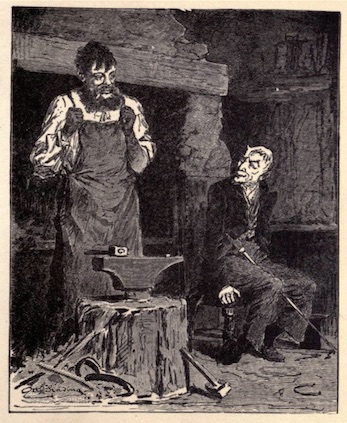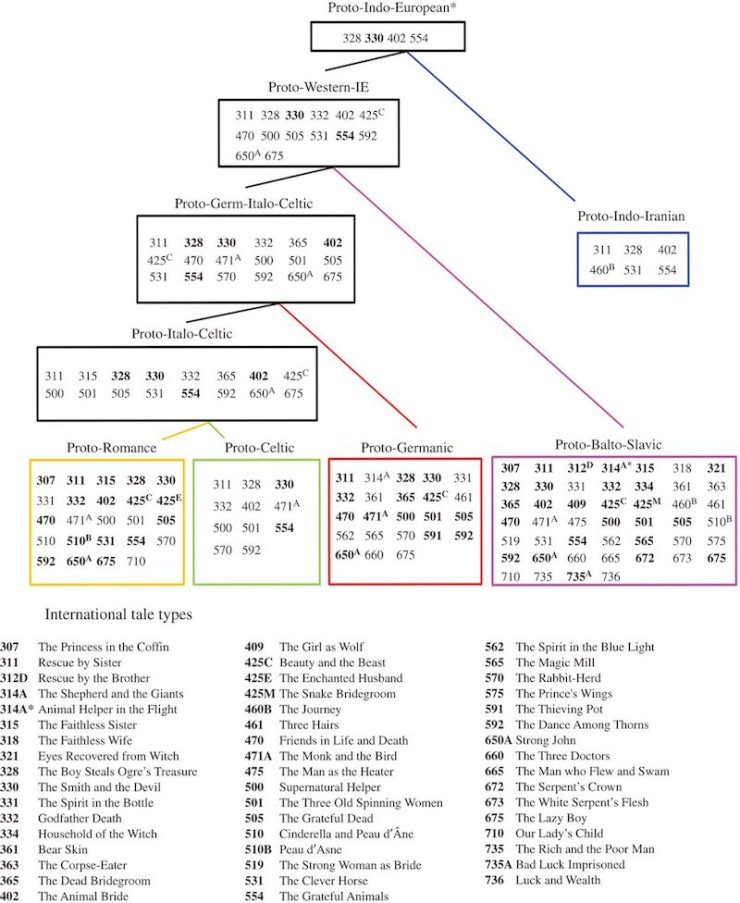While we know that the same fairy tales have shifted form and crossed over different cultures throughout history, linguists and anthropologists also assumed that they originated shortly before the time in which they were first written down. However, a pair of researchers have released a paper in which they used biological methods to trace fairy tales’ origins back not just hundreds, but thousands, of years. One in particular, “The Smith and the Devil,” may have come from as far back as the Bronze Age.
Social scientist/folklorist Sara Graça da Silva (from New University of Lisbon) and anthropologist Jamshid Tehrani (Durham University) created a phylogenetic tree, like the kind used in biology to trace evolution of species, to instead trace back the origins of popular fairy tales. (These methods have also been used in recent analyses of various cultural practices from marriage to music.) Starting with a list of 275 tales (all rooted in magic, it’s interesting to note), they narrowed it down to 76 stories, from which they then drew linguistic trees rooted in Indo-European languages. Analysis revealed that some of the stories were based on Indo-European languages that had since gone extinct, and/or certain stories (for example, “Jack and the Beanstalk”) had their roots in older tales. By looking back to the point where Western and Eastern Indo-European languages split, the researchers found themselves tracing back some of these stories to a point in history 5,000 years ago. As Phys.org points out, that means some of these tales predate certain Greek myths and the Bible.
Based on analysis of these 76 stories, da Silva and Tehrani reconstructed ancestral Indo-European tales to show the progression of certain tales. You might recognize ATU 425C “Beauty and the Beast” and ATU 500 “The Name of the Supernatural Helper” (which later became “Rumpelstiltskin”). While many folklorists had believed that these two tales were written down in the seventeenth or eighteenth centuries, these findings make the case that these stories existed in the oral tradition as far back as 2,500-6,000 years ago:
The bolded stories represent the situations “where tales could be securely reconstructed” (70% or more). In that case, let’s look at ATU 330, “The Smith and the Devil,” which seems to have originated in the Bronze Age about 6,000 years ago. The story is pretty straightforward: A blacksmith makes a pact with the devil (or Death, or a jinn, or another supernatural being), selling his soul in exchange for the power to weld any objects together. The blacksmith then uses his newfound power to weld the devil to a surface, forcing him to renege the soul part of the deal.
The Brothers Grimm collected “The Smith and the Devil” in their Children’s and Household Tales (published in 1812 and 1815), which is ironic, because Wilhelm Grimm was a proponent of this same theory of oral tradition. At the time, his beliefs that the stories he and his brother Jacob compiled were actually thousands of years old was shot down, but now he gets some vindication. You can read the entire paper in Royal Society Open Science.












Fascinating, thanks for posting about this.
Hold on… There’s an ancient fairy tale called “The Three Doctors?”
@2: Jacob & Wilhelm Grimm’s version.
@3: The link doesn’t seem to work.
@@.-@: Try this one.
@2: That was exactly my first thought after reading this :). Anyway, it’s just a translation – other versions, and the original, specify that it was three army surgeons. Too bad, an ancient fairy tale about three Doctors, possibly some strange blue box and maybe some aliens would be great.
@2: You know, I had never mad the connection with Doctor Who, but in retrospect, it’s obvious that if one of the doctors can survive the night without his heart, it clearly means he has a spare one.
Just two comments:
This is ironic considering that Tolkien’s central “conceit” was that of an archeologist of culture painstakingly reconstructing prior events hidden in plain sight.
and also, I wonder if any such work has been done of more epic-size material? What I mean, the Shah-Nama, the various epics referred to by the compilers of the Hebrew Bible, the Homeric epics and the Indian epics, the stories behind the Mabinogion, etc? These are folk-tales, after all, not epics, and it’s epics that tend to get written down. Also, these are Indo-European folk tales by the looks of it. Any work yet done on non-Indo-European? Like the Uralic? the Altaic aka Turkic? The Dravidian? The Austronesian? Bantu? Xhoisan? Athabascan? Inuit? Aleut? etc … ?
I have seen a theory where the Cinderella type story was Chinese in origin some aspect being the small foot in the more traditional tale and the uglies cutting toes and heels of to fit into the slipper
I’ve often pondered about the origins of the Sumerian Epic of Gilgamesh. Particularly the scene where the wild man Enkindu, who runs with the animals and is covered with fur, is seduced by the the temple-prostitute Shamhat and in the process loses his all-over body hair and is civilised. After his transformation the animals no longer accept him. Could this story be a retelling of long-remebered first encounters of Homo sapiens with Neanderthal and Denisovan species of Homo? If so, we are talking about possiby 100,000 years of story-telling, which is awesoume to imagine.
@9 There’s a Native American version of Cinderella, too. So it might not have originated in China.
There are also African versions of Cinderella too. I’m not sure how all that ties into their theory of tracing back through linguistics to a single indo-European source.
Reminds me also of an Australian aboriginal tale whice includes an account of a volcanic eruption causing someone to be trapped in a cave and die. All Australia’s volcanoes are long extinct. That’s one very old tale.
If you read the paper the authors aren’t saying that there is a single indo-European source for all stories, just that the availability of the specific database of folk tales, the archaeology and the known relationships between the Indo-European languages made this study possible. That a lot of work had already been done in the different fields that meant they could do this study making use of all that work. It is sadly the case that few other areas of the world have been studied as intensively.
@12/Lunetta: It seems more likely to me that there was contact between the indigenous Australians and the Pacific Islanders, many of whom settled on volcanic islands like Hawai’i. New Zealand was settled by Polynesians less than 750 years ago (the ancestors of the Maori people), so it seems likely they would’ve made landfall on Australia as well and had some cultural exchange with its inhabitants, even if they didn’t settle there.
Hey great article! Just a thought, “mankind” is a pretty outdated, unnecessarily gendered word. How about using “humanity” or “humankind” in the future?